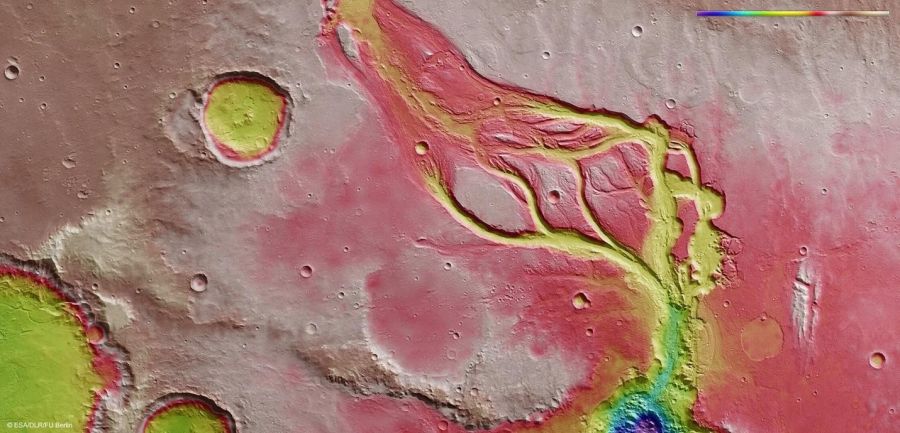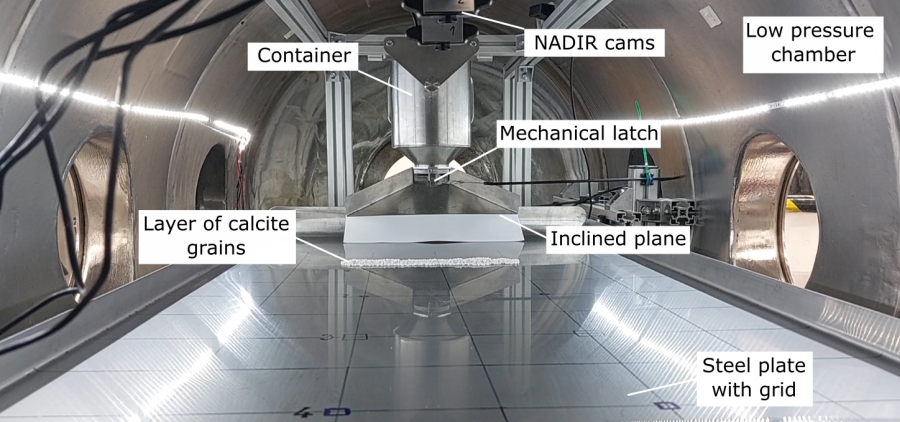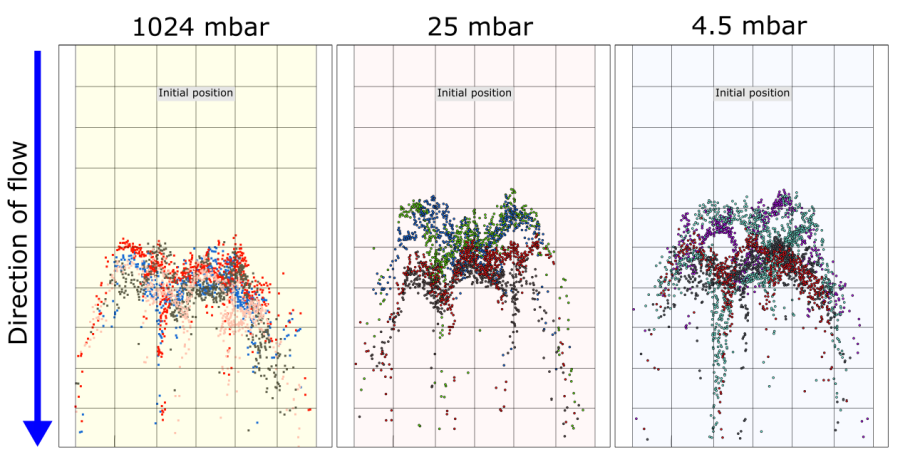- 1Institute of Geophysics of the Czech Academy of Sciences, Prague, Czechia
- 2Institute of Chemical Process Fundamentals of the Czech Academy of Sciences, Prague, Czech Republic
- 3School of Physical Science, STEM, The Open University, Milton Keynes, UK
- 4Space Science and Technology Department, STFC Rutherford Appleton Laboratory, Oxford, UK
Abstract
This study focuses on investigating the ability of water to carry out the mm-sized grains when exposed to low pressure environments in the attempt to help understand the depositional and erosional capacity of Martian streams (if they are present on today's Mars).
Introduction
Many edifices observed on Mars suggest that water once flowed over the martian surface and hence was present in the past (Figure 1) or might be still temporarily present even today [1-2]. However, as today’s Mars is a planet whose surface atmospheric pressure is ∼160 times weaker than that on Earth (~6 mbar vs. ~1000 mbar), water in a liquid phase cannot be present there for a prolonged period of time (e.g., [3]). This is because under such pressure, liquid water should boil, evaporate and eventually freeze due to the evaporative cooling (e.g., [4-5]).

Figure 1: Central portion of Osuga Valles in false colors as seen by European probe Mars Express, which formed by movement of a large quantity of water in martian history. ESA/DLR/FU Berlin, CC BY-SA 3.0 IGO.
As the boiling of water would lead to the formation of large quantities of bubbles, we expected that this would affect its ability to carry out the sediments and hence to change the erosional as well as depositional capacity of water streams on Mars. We speculate that two scenarios are possible: a) the boiling water will have a greater ability to entrain sediment because the emerging bubbles will formed around sediment grains and will be able to lift them, or b) that the bubbles in the water will reduce the ability of the sediment to entrain due to a change in the density contrast between the water and sediment due to the rapid boiling of water.
Experimental setup
To find out which hypothesis is correct, we performed a set of 13 experiments using the Mars Simulation Chamber at the Open University (UK), in which we studied the ability of unstable liquid water to carry sediments under normal (1024 mbar) and reduced atmospheric pressures of 25 and 4.5 mbar respectively. To achieve that, we developed a dedicated experimental setup consisting of a steel container holding 500 ml of water with salinity of 0.5% (D.I. water mixed with NaCl salt), from which the liquid could be released to 1° inclined steel plate (Fig. 2). A gridded area of 60x100 cm was marked on the plate, into which 20 grams of 2-4 mm-sized calcite grains were emplaced before the start of the experiment, 10 cm from the start of the grid. The grains were spread out in a rectangular shape in a monolayer rectangle of size 20 x 3 cm. The chamber was then closed and when the required atmospheric pressure was reached (1024 mbar, 25 mbar and 4.5 mbar), the latch at the bottom of the container was released and the water drained to the steel plate. The experimental runs were recorded by cameras occupying the experiment from the top, side and front. This allowed further post-processing, including grain movement and distribution analysis by DIC and statistical methods.

Figure 2: Image showing an experimental setup inside a low pressure chamber.
Results and discussion
Experiments conducted under normal pressure (1024 mbar) showed that most grains were able to get within 49-55 cm from the start of the grid (Fig. 3., Fig. 4a - blue points). In contrast, experiments conducted under reduced pressure of 25 mbar and 4.5 mbar showed that most grains only reached 38-50 cm (Fig. 3, Fig. 4a), respectively 37-49 cm (Fig. 3, Fig. 4a). In addition, with decreasing pressure, the grains were distributed along longer distances (typically 46 cm → 60 cm, black points) while the maximum reached distance by single grains was rather similar (Fig. 4a, green points).

Fig. 3: Results of experimental runs performed for pressures of 1024 mbar (4 experiments), 25 mbar (4 experiments) and 4.5 mbar (5 experiments) where each point corresponds to the finite position of calcite grain. The initial position of grains is marked with a shadow rectangle.
To quantify differences in sediment transport under different pressures, we performed a statistical analysis, specifically analysis of variance and cluster analysis. Analysis of variance, performed on the distributed calcite grains (Fig. 4b) for both orthogonal directions, shows increasing longitudinal (~5.4×104 → ~7.8×104) and decreasing lateral (12×104 → ~11×104) variances, while their ratio is near similar at about 0.5 in average.
Fig. 4: Results of measured distances and analysis of variance.
Experiments show that water has a greater ability to entrain grains under normal pressure when water is stable. Once the pressure drops and the water begins to boil and a large quantity of water vapor is produced within the flow, the ability of unstable water to entrain grains then decreases and therefore grains do not travel to such distances as in the case of normal pressure. Grains are also more scattered under decreased pressure. Hence, our preliminary results suggest that despite the current lack of knowledge of how atmospheric pressure has evolved in the Amazonian period, but once the atmospheric pressure dropped below the point at which water is stable, there would be changes in the water's ability to carry sediment.
As a next step, we plan to investigate by numerical modeling how the different gravity on Mars affects this process. This parameter can still significantly affect how much unstable water can carry away sediment on the Red planet.
References
[1] McEwen et al. (2011), Science 333, 740-743, [2] McEwen et al. (2014), Nature Geoscience 7, 53-58, [3] Hecht (2002), Icarus, 156, 373–386 [4] Bargery et al. (2010), Icarus, 210(1), 488–506, [5] Brož et al. (2020). Nature Geoscience, 13(6), 403–407.
How to cite: Broz, P., Pěnkavová, V., Krýza, O., Zedníková, M., Havlica, J., Sylvest, M., and Patel, M.: Effect of water on grain entrainment at reduced atmospheric pressure, an insight from analogue experiments , Europlanet Science Congress 2024, Berlin, Germany, 8–13 Sep 2024, EPSC2024-143, https://doi.org/10.5194/epsc2024-143, 2024.